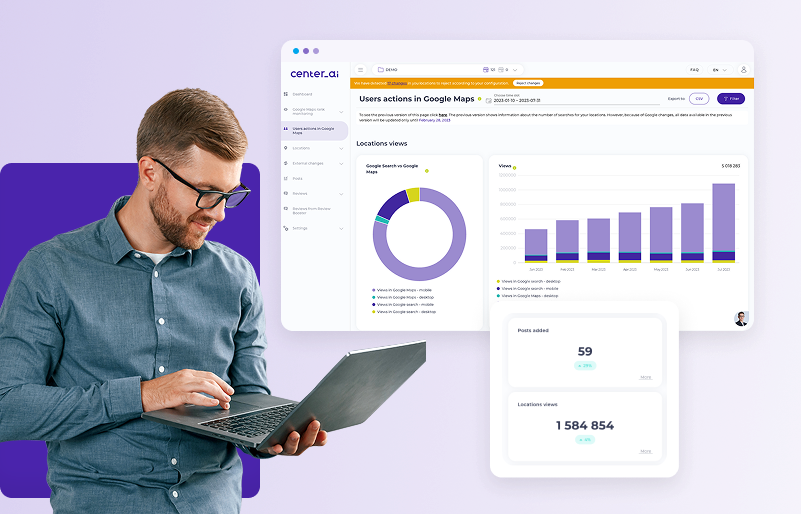Omnichannel marketing management: best practices in Customer Experience

Weronika
October 7, 2024
|
When consumers have countless touchpoints with a brand – from traditional retail stores through social media to mobile apps – creating a consistent and engaging customer experience becomes a real challenge. Omnichannel marketing management is no longer just a trendy concept but a necessity for companies wanting to build lasting relationships with their customers and stand out from the competition. The key to success is understanding how to harmoniously combine various communication channels, delivering valuable, consistent, and personalized content. To effectively reach today’s demanding consumer, it’s worth looking at best practices in Customer Experience within omnichannel marketing management.
How does omnichannel impact Customer Experience?
Omnichannel, or multi-channel marketing management, shapes customer experiences in today’s trade. This approach ensures consumers have consistent and unified communication with the brand across multiple platforms and touchpoints. In an omnichannel environment, consumers expect their interactions with the brand to be seamless, whether in a brick-and-mortar store, a mobile app, or a social media profile.
Leading retailers have mastered this by integrating digital and physical shopping experiences to make every interaction feel effortless. For real-world examples of how top brands implement omnichannel strategies, check out these Examples of Omnichannel in Retail. From curbside pickup to personalized mobile apps, these cases showcase how brands can elevate customer experience while driving engagement across multiple touchpoints.
Businesses often implement lifecycle marketing to effectively guide customers through each stage of their journey and foster long-term engagement. This strategy focuses on nurturing relationships across different customer lifecycle stages, ensuring that each touchpoint in the omnichannel experience contributes to building loyalty and driving conversions.
A strong omnichannel strategy isn’t just about being present on multiple platforms—it’s about ensuring they all work together seamlessly to create a smooth, personalized experience. Whether it’s AI-driven personalization, real-time inventory tracking, or frictionless transitions between online and offline shopping, leading brands are setting new standards. For more examples of omnichannel marketing, check out how top companies across industries are mastering the art of connected customer experiences.
Best practices in Customer Experience: consistent brand communication
Consumers don’t want to be surprised by discrepancies in communication or offers across platforms, as these inconsistencies complicate purchases and can lead to frustration. With easy access to information, everyone now expects quick answers and uniform information at every step of their purchasing journey. That’s why companies adopting an omnichannel strategy invest in technologies and tools that monitor customer interactions across platforms and tailor communication to individual needs. This results in a more satisfying customer experience and building lasting relationships with the brand.
Customer feedback and omnichannel marketing management
Genuine feedback is key to understanding the needs and expectations of customers. In the context of omnichannel marketing management, reviews become not only an indicator of customer satisfaction but also a valuable source of information about which communication channels are most important and effective. Managing and responding to feedback is an essential element of the strategy for any company striving for operational excellence in the area of Customer Experience. It’s worth monitoring and analyzing feedback from various sources – from social media to official websites to Google Maps. In the digital age, consumers have countless ways to express their opinions – positive or negative – and in places where it’s accessible to a wide audience.
Best practices in Customer Experience: managing reviews in Google Maps
Google Maps is a prime example of an online space where consumers readily share reviews. For many, checking its ratings is the first step before visiting a physical location – be it a restaurant, shop, or service point. These reviews often influence the decision to choose or reject a particular brand. By analyzing reviews on Google Maps, brands can gain insights into what customers truly think about their products, services, or even customer service. Often enriched with photos, such reviews provide a real picture of consumer experiences, highlighting what’s important to them and what needs improvement. Responding to positive and negative reviews is crucial for maintaining a positive brand image. While positive reviews are naturally beneficial, the way a company responds to criticism often plays an equally, if not more, important role. A quick, professional, and polite response to a negative comment can turn an unhappy customer into a loyal brand ambassador. It’s essential to show that the company cares about its customers, listens to their feedback, and makes improvements.
From Google Maps to Social Media: effective channel integration
Effective omnichannel marketing management requires an integrated approach to all channels where the brand is present. Their diversity allows them to reach various target groups and deliver a personalized experience regardless of where and when they encounter the brand. Expanding on the example of Google Maps, which is a navigation tool and a powerful marketing platform, it’s essential to understand the role of each channel in shaping the Customer Experience. Google Maps allows businesses to appear at crucial moments in the customer’s purchasing journey. This can be a restaurant recommendation nearby, a suggested gas station on the route, or a special promotion in a nearby store. By combining this information with social media channels, companies can create consistent and engaging messages that lead to deeper consumer interaction.
To learn more about increasing store visits through strategic marketing, explore our guide to drive to store marketing.
Modern omnichannel marketing, of course, encompasses much more than just Google Maps and social media. Online stores, mobile apps, emails, chats, and even traditional channels like television or radio should be included in the strategy. Integrating these channels means that customers can start shopping online on their smartphone, continue on a desktop computer, and then pick up the products in a physical store – all with a uniform and consistent experience.
Which data should be analyzed in the context of omnichannel and Customer Experience?
Companies need to analyze the relevant data to effectively manage omnichannel marketing. Metrics such as the number of visits to a company’s profile on Google Maps, the number of clicks on promotional links, or interactions on social media can provide valuable insights into customer behavior. Moreover, analyzing customer feedback from various channels helps companies understand which aspects of their omnichannel strategy are most effective and which ones need improvement. Here are some key data areas that companies should consider in the context of omnichannel and Customer Experience:
Customer Journey: It’s not just about the number of clicks or visits to the site but understanding how and why a customer navigates through specific channels before purchasing. Analyzing the purchase path can help identify where customers encounter difficulties or give up buying.
Conversion rates across channels: Metrics such as CTR (Click Rate) in ads, the conversion rate on product pages, or the effectiveness of an email campaign can help understand which channels and techniques deliver the best results.
Site interactions: The time spent on the site, the number of visited subpages, and the bounce rate can provide information on whether the content is engaging and meets user expectations.
Reviews and feedback: Both positive and negative customer feedback are valuable. Analyzing these reviews, especially those posted on social media, Google Maps, or product pages, can provide insights into what customers really think about the brand and its products.
Loyalty metrics: Metrics such as purchase frequency or repeatability will help determine whether the omnichannel strategy effectively builds customer loyalty.
Customer support metrics: Response time to inquiries, the number of open and closed tickets, or feedback on support can indicate whether customers are satisfied with post-sale interactions.
Data integration: In an omnichannel environment, data integration across different platforms is essential. This allows companies to get a complete picture of customer behavior regardless of the channel.
Analyzing this data will allow companies to identify strengths and weaknesses in their omnichannel strategy. As a result, they can make necessary adjustments to optimize Customer Experience and strengthen their market position.
Managing omnichannel marketing and ensuring a positive customer experience is key to success in today’s competitive business environment. Companies that can effectively integrate different communication channels and deliver personalized content have the chance to build lasting relationships with customers and stand out from the competition.
Share article:
Search Blog
Most popular posts
Join the newsletter
Receive the latest content on reputation building and boosting foot traffic in brick-and-mortar stores.








